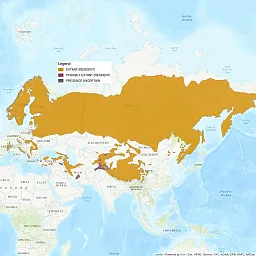
Eurasian lynx. From a re-introduction program into the Harz Mountains in Niedersachsen, Germany. © Nasser Halaweh · some rights reserved
Eurasian Lynx
Species Facts
The Eurasian lynx is also known as the European lynx, the boreal lynx, the palearctic lynx, and northern lynx. With its ear tufts, short back, and stubby tail, this multi-named lynx has the look of a bobcat.
- Scientific Designation: Lynx lynx
- Endangered Status: Least Concern (LC)
- Lifespan: Up to 17 years (in the wild)
- Weight: 18-35 kg
- Length: 80-100cm
- Shoulder Height: 55-70 cm
- Tail Length: 15-25cm
Appearance
This species is much larger, longer-legged, and has bigger feet than the bobcat (it is the largest of all bob-tailed cats). Its legs are thick and powerful, with wide paws to match. The paws of the Eurasian lynx are highly adapted for moving through deep snow, with well-developed webbing between the toes and long, dense, shaggy hair in the winter.
The lynx is thickly furred with large ears that are adorned with an erect tuft of black hair. The Eurasian lynx is adapted for cold-weather environments: long, silky fur provides insulation from the cold in the winter, while the summer coat is shorter, sparser, and coarser. The fur color is highly variable, with white underparts. The winter coat can be silver-gray, yellowish gray, or grizzled grayish brown. The summer coat is more reddish or brownish. Furthermore, the spot pattern varies from almost none to a number of highly visible black spots.

Species Distribution
Lynx were once widespread in the forest and forest-steppe regions of the Old World, from northern Europe, across Russia, to northeastern Siberia and China. However, in modern times, their range has shrunk dramatically within these areas. The lynx is a forest-dwelling species. Its habitat use patterns are defined largely by the abundance and distribution of its prey (small ungulates and arctic hares). The species is found at elevations up to 4,500 meters. The lynx spends its day hidden in dense cover, perhaps sleeping in a tangle of fallen trees or within a rocky cavern, and emerges in the late afternoon. These cats are usually solitary.
Distribution map courtesy of IUCN (International Union for Conservation of Nature), compiled in 2015.

Central European Lynx observed on a camera trap in Valea Ierii, Romania. © mihaipaulc · some rights reserved
Threats to the Eurasian lynx
Eradicated from many parts of its former range in Europe, intensively hunted for their fur, and considered a threat to other wildlife populations, Eurasian lynx are restricted to forest areas within their range. Threats to the species include habitat fragmentation, loss of prey species, activities related to human population growth, and poaching. The Eurasian lynx is classified as Least Concern (LC) by the International Union for Conservation of Nature (IUCN) and protected under appendix II of the Convention on International Trade in Endangered Species (CITES).
Want to help us research and conserve this species?
Felidae Conservation Fund helps researchers around the world study and protect felids of all sizes.
Make sure you write a comment with "Eurasian Lynx" so we can designate 100% of your donation to go to protecting this species.
Do You Have 2-4 Hours A Month To Preserve Your Local Ecosystem?
Our volunteers are the driving force behind making true change in ecosystem health and wild cat conservation. Some like to volunteer in the field, others help us maintain our online presence, and some work with events. With just a few hours a month, you can make a difference, too.
Make A Difference Right Now
As a 501(c)3 nonprofit, our work is only possible because of generous donors like you.
More than 90% of your donation will go directly to our groundbreaking research, outreach, and education programs.
This is where true change starts. If you’d like to be a part of it, make a donation to Felidae Conservation Fund today:
Or,
